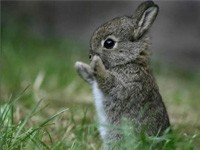The body of the hare. Description of the hare
The message about the hare for children can be used in preparation for the lesson. The story about hares for children can be complemented by interesting facts.
Report on hares
Hare - an animal that belongs to the class of mammals, lagomorphic order. There are about 30 species of hares that live around the world, with the exception of Antarctica. In our country, there are four species: white hare, hare, tolai and Manchurian.
Description of a hare
Hares - animals of small or medium size, body length is 12-74 cm, weight reaches 7 kg. The hind limbs of large species are elongated. Females are larger than males. The tail is short, almost invisible from the outside.
The hair of the hares is rather thick, and the color of the body varies depending on the season. Hares molt 2-3 times a year. In the summer, the hare can be gray, brown or black-brown, and in winter it brightens or becomes white entirely.
A characteristic feature of hares-like are wedge-shaped ears, reaching a length of 9 to 15 cm. Thanks to the ears, the ear of a hare is much better developed than the sense of smell and sight. The hind limbs of these mammals have long feet and are more developed than the front ones. In the event of a threat, the speed of the hare can reach 80 km / h. And the ability to suddenly change the direction of the race and jump sharply to the side allows these animals to get rid of the pursuit of enemies: a wolf, a fox, an owl, etc. Hares run well up the slopes, but have to go down head over heels.
How many live hares?
Life expectancy of males does not exceed 5 years, females - 9 years, however there are documented cases of a longer hare life - about 12-14 years.
In natural conditions, hares live either singly or in pairs. During the year, these animals thrice occurs three times. The gestation period of a hare lasts up to 50 days. In one litter there may be from 1 to 9 hares. Offspring is born sighted and capable of independent movement. In the first 5-7 days, the hares need milk, but by the 2-3 week of life they switch to grass food and become independent. Sexual maturity comes to the next spring.
What do hares eat?
Food ration depends on the season. Bean, underground mushrooms and grass hares eat in summer. In winter, food becomes bark and small branches of young trees - willow, hazel, aspen and birch. In the spring, hares start gathering on the lawns with young grass and are so addicted to fresh food that they lose their proper care.
The hares have no permanent holes, they constantly change the places of the lezhe. In winter, hare's beds are located in thickets, brushwood and other hard-to-reach places. And in the fall, when frequent rains, and water is constantly dripping from the trees, the long-eared ones settle on open meadows in the grass.
Hares are an object of developed fishing, especially in the northern regions. They get fur skins, meat and hair for the felt industry.
Hopefully, the information presented about the hare helped you. And you can leave your report on the hare via the comment form.
The hare is a family of mammals from the order of lagomorphs with a body length of 12 -74 cm, which includes the hares and rabbits themselves. In large species of hares, the hind limbs are elongated, the ears are strongly elongated.
They have a well-known "hare" look. Small species of hares have almost the same length of the front and rear limbs and low round ears. The tail is invisible on the outside or very short, covered with hair. The front limbs of hares are five-fingered, back four- or five-fingered. The toes are well developed claws. The soles of the paws are covered with hair. Nostrils are surrounded by a strip of bare skin. The blades of the upper and lower lips are able to close behind the incisors in the midline. The coat of hares is soft and thick, only a few of them have a hard, bristle-like, thinned. In many species of hares, the hairline varies according to the seasons of the year, both in structure and thickness of hair, and in coloring. Its color is gray, brown or ocher in most. A strip of hair-covered skin juts into the mouth along the dentition — approximately at the level of the lower cheek teeth. There are no sweat glands in the skin of the hares; available only on the soles of the paws. Anal and inguinal skin specific glands are common. Nipples 2-5 pairs.
Hares are distributed throughout the globe, with the exception of Antarctica, the southern part of South America, the Australian region, New Zealand, Indonesia (except for Sumatra Island), Madagascar, the Philippine Islands and the islands of the Caribbean. With success acclimatized in Australia, New Zealand, in the south of South America, Java and on various islands of the Atlantic and Pacific Oceans. They inhabit all zones from arctic tundra to tropical forests and deserts. In the mountains rise to the alpine and subalpine zones.

Hares are terrestrial. Some are colonial, others are found one by one. Do not fall into hibernation. Active during the day (pikas) or at dusk and at night (rabbits and hares). Some hares are great runners. Asylum are burrows dug by them, crevices of rocks, overgrown with grass and bushes. Food exclusively herbivorous. They prefer the green parts of herbaceous plants, they also eat the bark of bushes and young trees, sometimes their twigs. Hares are characterized by eating their own feces containing vitamins (coprophagy).
The breeding season lasts 2-4 months. In the middle zone it usually breeds twice per summer, in the north - once. Pregnancy lasts 48-51 days, young animals become adults only after wintering. The main rut in the spring, accompanied by fights of males. Fighting males stand on their hind legs and "box" their forepaws. At this time, on the edges and clearings, trampled patches come across - hare dance floors (8). Hares lose their caution and more often come across their eyes. By the way, in many European countries the expression "March Hare" means the same thing as our "March cat". Hares (1-6, less often up to 12) are born sighted, with thick fur and at first sit in the grass motionless, so as not to leave traces, and the mother comes to feed them 1-2 times per night. At the same time, she feeds not only her own hares, but also others. In places where there are a lot of hares, all hares sometimes become common.

In the late spring, small hares climb into heaps of dung or rotten stacks to protect themselves from the cold. But taking a rabbit found in the field is not worth going home: a hare usually manages to grow it, but people are unlikely. After 8-10 days, the hares begin to eat grass, but they feed on milk for up to 20-30 days.
Species that live in burrows or natural shelters, bring bare or covered with hair, but blind young, and living on the surface of the earth - sighted young, covered with hair, able to move immediately after birth. Some types of detachment have hunting and commercial value and are mined in large quantities.
Hunting a hare is one of the most common types of hunting. Almost every time, going hunting, hunters know that the characteristic habitat for the hare is the forest zone, and for the hare it is preferable to have a hare. For a hunter, a white hare is essential as an object of fur trade and sport hunting, but the methods of catching are not so diverse, of which the most common hunt is maliku, in which the hunter, finding the hare’s night trail, tries to find him on a mat, and also one of most gambling and incendiary, this is a hunt with hounds of dogs.
Some species cause great damage to pastures, orchards, forest plantations. Some species spread carriers of natural focal infections. On the territory of the USSR, there are 5 species - the Manchu, wild rabbit, white hare, hare, and Tolai.


